Blog
Archives
.
. . from 2012 to current
Wildlife
News Summaries
- Fortnightly
summary of local wildlife news
SATURDAY
JULY 16 - 2016
Brook
Meadow
I had a slow
mooch around the meadow on a very warm and humid
summer afternoon.
On the way to the meadow up Victoria Road, I was
surprised to see quite a lot of Toad Rush
growing in the gap between the pavement and the
garden walls. I usually associate this plant with wet
conditions on Brook Meadow, though clearly this is not
always the case.

Approaching Brook
Meadow down Seagull Lane I was confronted by the large
Buddleja in full flower near the entrance gate,
but with not a single butterfly.

The interpretation
board is gradually getting engulfed by shrubs,
etc. I shall ask the conservation group if they can
clear it at the next workday.
I can't see anything of the Broad-leaved
Everlasting-pea which struggles every year to
climb through the jungle of vegetation on the Seagull
Lane patch. This year I suspect it might not make
it.
The Oak tree that I planted four years ago on
the Seagull Lane patch is growing well and looking
healthy and is catching up with the Red Oak which was
might taller when planted at the same time in memory
of Tony Wilkinson.
Square-stalked St
John's-wort is now in flower on the orchid area on
the north meadow. Also on the orchid area there are
lots of Yellow Rattle with seed cases, but not
rattling as the seeds have largely dispersed.
I am fairly sure I
located Spiked Sedge on the orchid area, much
thinner than False Fox Sedge with a smaller panicle.
That takes the total count of sedges recorded on Brook
Meadow this year to 13. Only Hairy Sedge is not
found.
Great Burnet is still showing wonderfully well
on the orchid area with dozens of bright red flower
spikes.
I found the first
Michaelmas Daisy of the year on the east side
of the Lumley area. Soon there will be thousands!
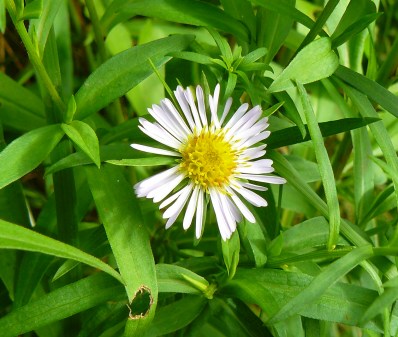
The Marsh
Woundwort flowers are coming along very well at
the start of the eastern path through the south
meadow, just south of the Weeping Willow.
The young Horse Chestnut trees on the south
meadow have been badly affected by the mite that
burrows into the leaves, making them brown.

Ralph
Hollins added: This is the result of millions of tiny
caterpillars of the Horse Chestnut Leaf Miner moth
(Cameraria ohridella) having eaten their way through
the outer skin of the leaves to find a safe haven from
predators (such as Blue Tits) between the top and
bottom 'skin' of the leaf. The caterpillars stay
within the leaves through the rest of the year and
fall to the ground with the leaves in the autumn,
eventually emerging as mature moths next spring to
restart the cycle. This moth has had a recent
significant expansion of its range and only reached
the UK in 2002 but looks set to stay.
A wide path has been
cleared alongside the bund adjacent to the Gooseberry
Cottage garden, presumably by the Environment Agency.
It looks as if the work is not finished as the
southern section leading to Peter Pond has not yet
been cleared. I hope the Celery-leaved Buttercups and
Hairy Buttercups managed to set seed before this
happened.
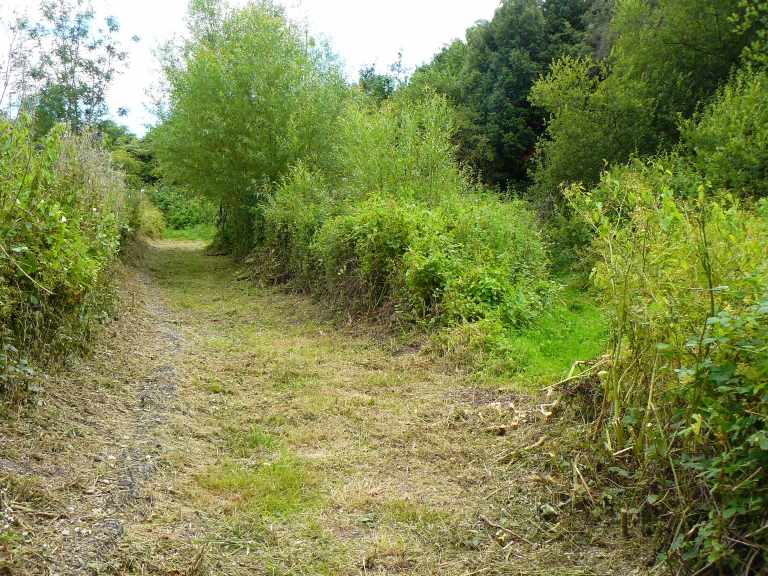
The best experience of
the afternoon came while walking through Palmer's Road
Copse with a Song Thrush singing strongly and
Stock Dove cooing gently. I came across my
first crop of Giant Fescue beside the path from
the south bridge at Grid Ref: SU 75073 05924. Note the
broad leaves and the drooping panicles. This takes the
total number of grasses recorded on Brook Meadow this
year to 28.
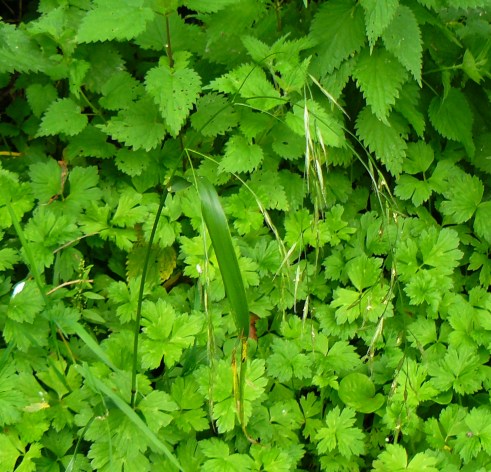
Also growing well in
this area was a very distinctive dock with long
leafless flower spikes which I thought could be
Fiddle Dock, though Docks are certainly not my
strong point! I could see some fiddle-shaped leaves.
However, people I have consulted on Facebook do not
agree and think it is Wood Dock. Oh, well.
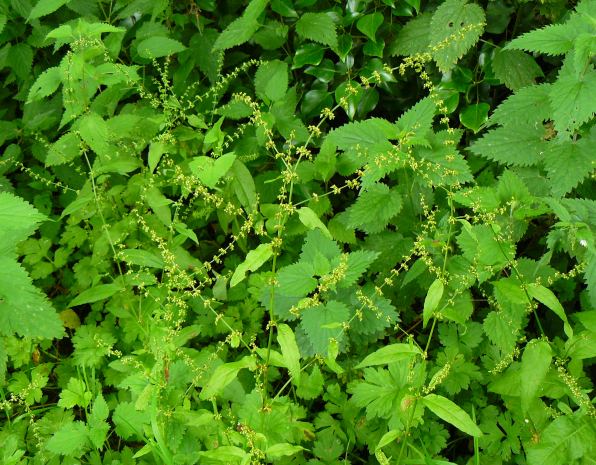
Also flowering well
along this path was Enchanter's Nightshade -
the only place this plant grows on Brook Meadow.
Further north along the path through Palmer's Road
Copse is a good growth of False Brome also with
drooping panicles, but hairy and more delicate than
Giant Fescue.
There were not as many
butterflies as I expected, but did manage to see Red
Admiral, Comma and lots of Whites. Here is a splendid
Comma that perched for me near the Lumley
Stream. I found yet another Strangalia
maculata beetle by the Lumley Stream. They are
so common this year? Or just easy to spot?
Lots of gulls were
wheeling around in the sky. Is this ant flying time?
Warblington
shore
Peter
Milinets-Raby was out this morning to walk along the
Warblington Shore (6:37am to 8:52am - tide pushing in
and very warm!!)
Warblington Cemetery: Coal Tit in the Yew Trees.
Female and juvenile Green Woodpecker (see photo). 2
Song Thrush, Chiffchaff Heard,
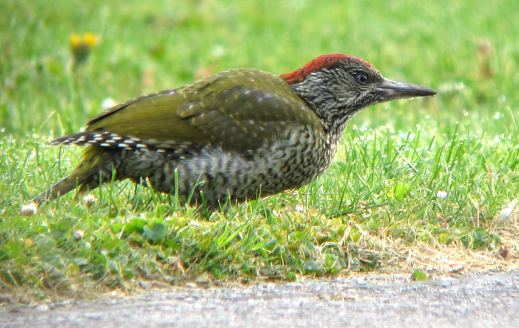
Hedgerow: 4 Reed
Warbler (2 ads feeding 2 juvs), Female Blackcap, 2
Singing Chiffchaff heard.
Conigar Point: 2 Reed Warblers in Tamarisk Hedge, 1
Greenshank (G//R + GO//-), 2 Shelduck, 2 Mute Swan, 1
Great Black-backed Gull, 2 Common Tern, 1 Black-tailed
Godwit.
Off Pook Lane: 6 Greenshank (RG//- +YY//- & G//R +
YN//- & G//R + LL//-), 3 Swallows, 14+ Goldfinch,
1 Whimbrel, 3 Med Gulls, 2 Common Tern, 1 Great
Crested Grebe, 27+ House Sparrow .
Langstone Mill Pond: Tufted Duck female with duckling,
17+ Swallows over and 1 Swift, 36+ Little Egrets and a
Cormorant in the trees, 2 Reed Warblers, 2 Reed
Bunting male and a young male.
Silver-washed
Fritillary
Barrie Jay got
this excellent Silver-washed Fritillary a bramble bush
today - our first report of the year. They must be out
in Hollybank Woods surely?
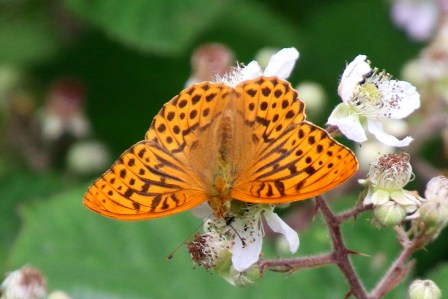
Portsdown
Hill
Ros Norton
reported on this morning's walk by the Havant Wildlife
Group
"Today a group of 12 met in car park near the
Churchillian for a walk going west on a lovely sunny
warm morning. We started around back of Fort Widley
then crossed the road and walked west to
roundabout.
Butterflies were active early and we saw many marbled
whites and meadow browns, also comma, red admiral,
whites, gatekeeper, large and small skippers and small
tortoiseshell.
Other insects included bush -cricket, green thigh
beetles, 7 spot ladybird, soldier beetles, bees, a
blue hawker dragonfly and a lacewing.
Highlight was a distant sighting of 3 hares in a
field.
Yellowhammers and greenfinches were singing well.
Other birds included blackcap, stock dove, jackdaws,
swallows, linnets and goldfinches.
There was an amazing variety of flowers especially
yellow hawkbits and greater knapweed. Too many flowers
to list all but they included bladder and white
campion, a bee orchid, many pyramidal orchids, common
spotted orchids, golden or tall melilot, Lucerne, rest
harrow, kidney vetch and tufted vetch. There was
upright hedge parsley, masses of hogweed, wild carrot
, wild parsnip, field and small scabious. vipes's
bugloss, ladies bedstraw, yellow-wort, common and
lesser centaury, pale flax, fairy flax, harebells,
nettle leaved bellflower, vervain, wild basil,
marjoram, hedge woundwort, yellow rattle, musk mallow,
and mignonette.
FRIDAY
JULY 15 - 2016
Cuckoo
back in Africa
The British
Trust for Ornithology reports that the Cuckoo that was
satellite tagged in the New Forest on 16 June has made
it across the Sahara desert and is now in Mali in
Africa. This beats the earliest crossing of the desert
by a satellite tagged Cuckoo by 6 days. Between 2am on
9 July and 10.30am on 10 July he flew 1,774km (1,102
miles) at an average speed of around 50kph, and all
into a light south-westerly headwind. To see the full
story go to . . . https://www.bto.org/science/migration/tracking-studies/cuckoo-tracking/161321
Sibling
rivalry
Tony Wootton
had Starlings on his bird feeder this morning. You can
see the adult feathers coming through on the chest of
the one facing us.
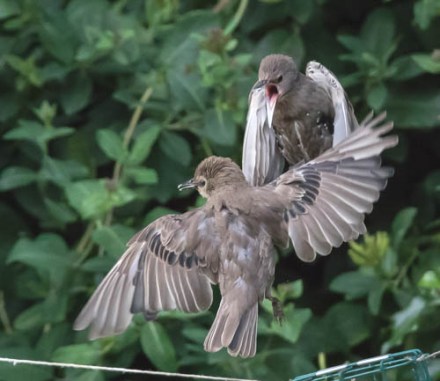
Eric's
moth
During a walk
around Fort Widley nature trail this morning Eric
Eddles found this moth - Roeslerstammia
Erxlebella.

I have never heard of
this moth, so I consulted UK Moths which says, "This
distinctive metallic-golden micro has, when fresh, a
purplish-bronze tinge to the area around the base of
the forewings. It also sports a noticeably yellow
crown and has a white band close to the tip of the
antennae. Mainly distributed in the southern half of
England, there are also scattered localities in Wales
and in Scotland where the species occurs. The larvae
feed on the leaves of lime (Tilia) and birch (Betula),
mining the leaves when young. There are two
generations, at least in the south of the range, with
adults on the wing in May and June and again in August
and September."
THURSDAY
JULY 14 - 2016
Waysides
News
I had a stroll
around some of the local waysides this afternoon. Here
are a few things I noted.
Several flower spikes of Marsh Woundwort are
now out on the west side of the Washington Road path
just north of the A27 road underpass. This was the
first sighting on this wayside since 2012.
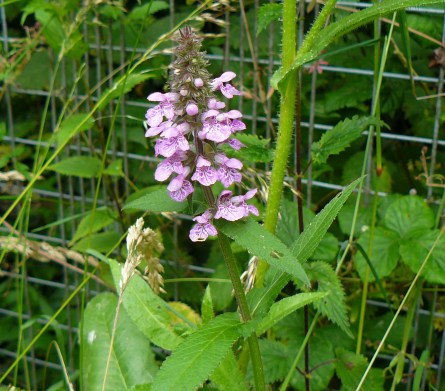
The first flowers are
now opening on the Greater Burdock plants in
front of the pony field near the Emsworth Recreation
Ground. There are a large number of plants in this
patch, so when the flowers are all out it should be a
good show!
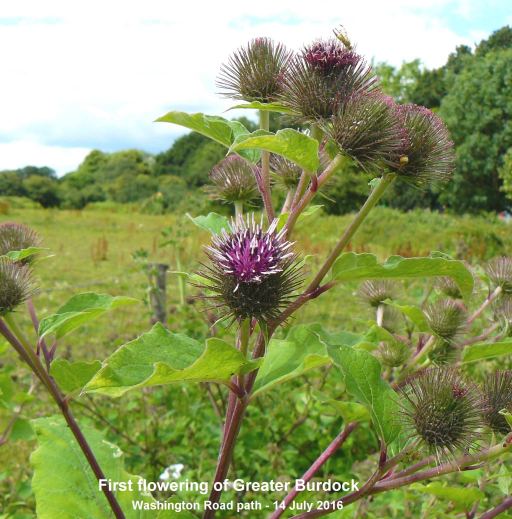
Moving onto the
Recreation Ground the grassland behind the bowling
club is now past its best. However, I did note some
Creeping Thistles with white leaves on the
northern area near the wire fence. I looked it up on
Google and discovered that white leaves are called
chlorosis and caused by a bacterial disease called
Pseudomonas syringae. The Llanelli
Naturalists were puzzled by this phenomenon in 2008
and wrote a short article called 'The mystery of white
thistles'. The disease is relatively new to Britain
having been discovered by Dr John Fletcher near
Canterbury in 2002.
For more information see . . . http://www.llanellinaturalists.org.uk/index.php/March-2009/the-mystery-of-the-qwhiteq-thistles.html

Finally, I had a look
at the grass verge at the north end of Christopher Way
by the final green lamp post which had been recently
mown by Council workers. Amazingly, some Wild Clary
plants were coming up again, some with small
flowers. What robust plants they are, but they really
need to be given more of a chance to develop into full
grown plants. So, I shall ask Jayne Lake of Norse
(Havant Borough Council) to instruct the Council
cutting team to avoid this verge until after the end
of the growing season.
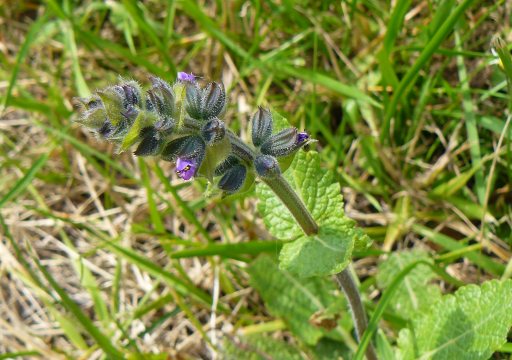
Other
news
Brian Lawrence
had a walk along the Billy trail from Langstone Bridge
and had a great day for seeing butterflies with lots
of Marbled White - a good year for them? Also,
Skippers, Whites and Gatekeepers. Here is a Marbled
white on some Knapweed.
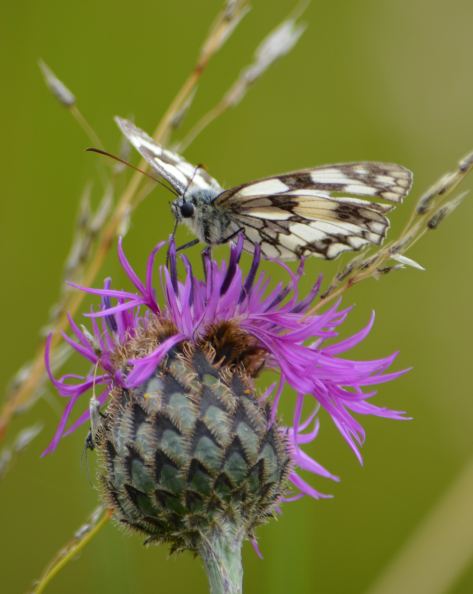
Ken and Romney Turner
had this fine fellow visiting their garden this
morning. Maybe a youngster?
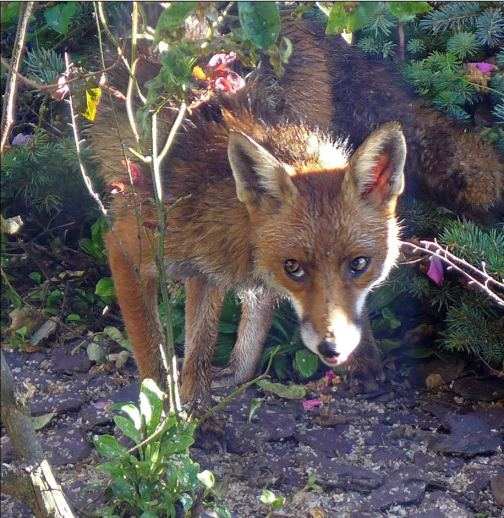
WEDNESDAY
JULY 13 - 2016
Slipper
Millpond
When I arrived
on my bike, members of the Slipper Millpond
Association were working on the east side of the pond
to reinforce the bank against erosion. Two juvenile
Great Black-backed Gulls were on the nesting
raft with one adult. The other juvenile gull was on
the water nearby.
A Coot is sitting in
the nest box on the north raft, but there was none in
the box on the south raft which has a fine display of
Perennial Sow-thistle and Sea Mayweed. Here is the
south raft with its display of wild flowers.
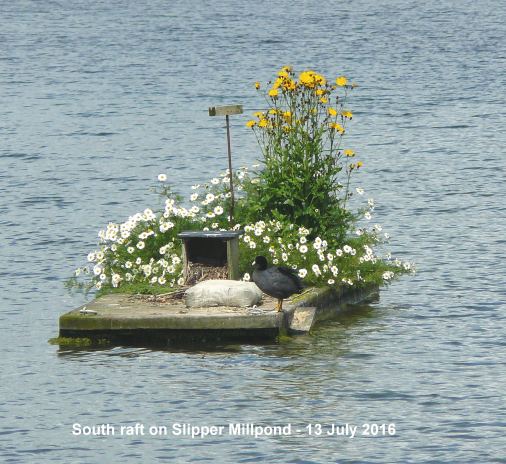
Nick Madina who was
with the team working on the east bank told me had
seen three Coot chicks earlier in the season, but
taken by the gulls which had also taken one of the
tiny swan cygnets and probably some Mallard ducklings.
However, I get the impression that the large gulls
have caused less consternation among the local
residents than in previous years.
Hedgerow
Crane's-bill was in flower on the east side of the
pond, which I don't recall having seen here before,
though there is plenty on the marina seawall which is
not too far away.
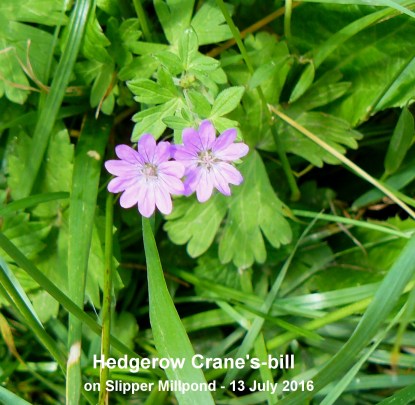
Waysides
News
Vervain
is now flowering on the Bridge Road Wayside, in
exactly the same place and the time as in previous
years.
Langstone
Mill Pond
Peter
Milinets-Raby popped down to Langstone Mill Pond this
afternoon 1:52pm to 2:41pm - tide out. His
observations -
Off shore: 3 Greenshank, 2 Great Crested Grebes, 1
Sandwich Tern, 2 Common Gull, 1 Redshank with rings
-//B + B//GG (last seen in Sept 2015), 2 Med Gulls, In
the channel by the Pub (for second day running) the 2
adult Mute Swans and 8 cygnets.
On the pond: Tufted Duck female with one duckling
(again). This could be the mother of 13 and this is
all she has left - shame!
Passing over west, 11 House Martins and 3 Swifts. 62+
Mallard counted - virtually all in eclipse plumage
now. 27+ Little Egrets left, three adults still
sitting on nests (see photo of how tiny one set of
young still are).
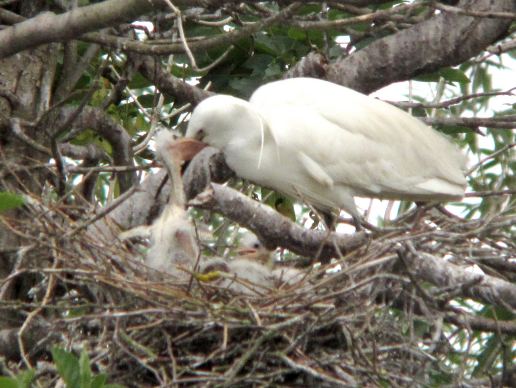
Grey Heron Other Holm
Oak nest three young getting ready to fledge. Reed
Bunting still singing (see photo). In spiral over the
pond, 3 Med Gulls, a Kestrel, 2 Buzzards and 5
Swallows.
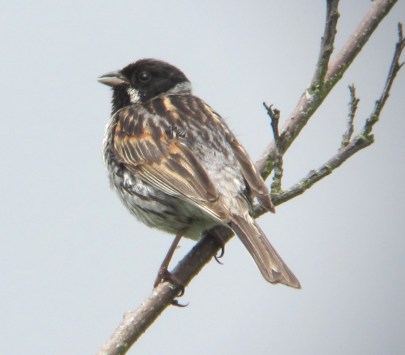
Eric's
Moth
Yesterday as
Eric Eddles returned home from his afternoon walk
around Baffins pond he went to open his front door and
found this moth called Pammene regiana
on his hand Luckily he had a camera handy and was able
to capture a few shots before it flew off.
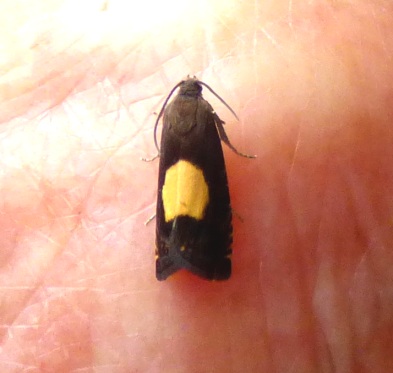
TUESDAY
JULY 12 - 2016
Brook
Meadow
I had a little
wander around the meadow this morning on the way to up
date the Water Vole signcase. Looking around the
orchid area which is now much overgrown, I could see
Cinnabar caterpillars had discovered Hoary
Ragwort. This attractive plant, which is not yet
in flower, is abundant in this area and is an
important source of nutrition for these insects as
well as providing an important nectar source from its
yellow flowers for late flying insects.
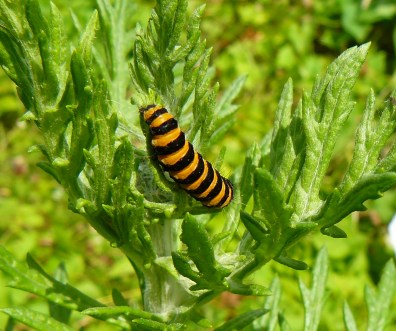
Moving down to the
Lumley area I was pleased to see the first
Marbled
Whites of the
year on the meadow. Other butterflies seen this
morning included Comma, Meadow Brown, Gatekeeper,
Large Skipper and Red Admiral.
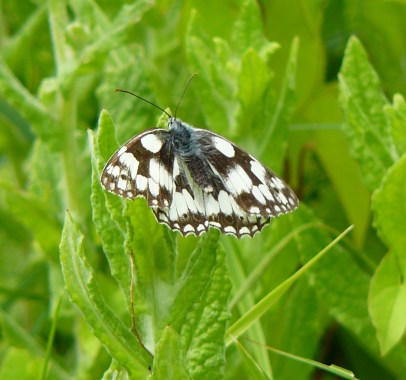
On the path around the
Lumley area I saw another Strangalia
maculata beetle, this time feeding inside a
flower trumpet of Hedge Bindweed. Also along this path
were the flowers of Strawberry Clover. Soon
they will have their distinctive strawberry-like
fruits from which the plant gets its name.
I spotted some
interesting grasses flowering just inside the Lumley
gate which could be Smaller Cat's-tail. They
were Timothy shape, but with much smaller panicles
than I would expect from that plant. However, I am
aware that these two species are very difficult to
separate, so would not wish to give a firm
identification. After reviewing all the possible
differences, Cope and Gray (p. 406) concluded "No
single character is wholly reliable (in distinguishing
Timothy and Smaller Cat's-tail) except chromosome
number".
I must admit having
almost given up on finding any Marsh Woundwort
in the tangle of vegetation on the south meadow, but
today I did find a few flower spikes pushing up
through the jungle in the usual area just south of the
Weeping Willow. I counted 7 spikes in all, but more
should appear in time.

I checked the likely
Water Vole burrow holes on the east bank of the
Lumley Stream, but saw nothing in the 10 mins or so I
was present.
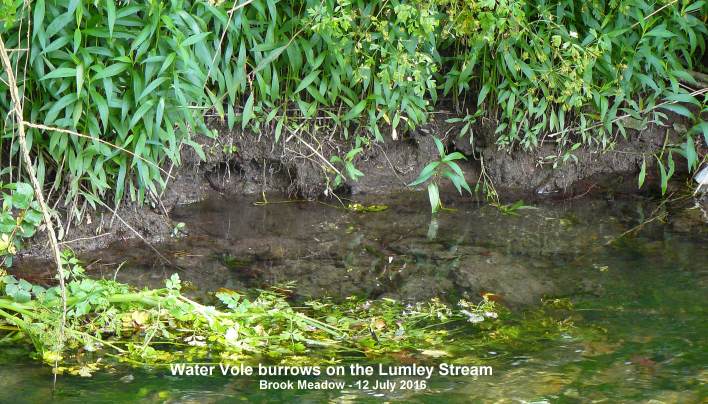
While waiting, I was
interested to see an Elm branch overhanging the
stream with corky ridges. I had thought this was due
to Dutch Elm Disease, but I read that it is, in fact,
a common feature of Elm branches and twigs.
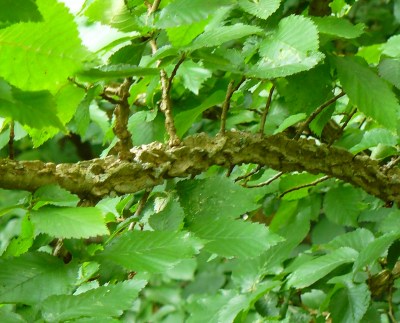
Finally, I went round
into Palmer's Road Copse to clean and up date the
Water Vole signcase. It was in a very bad
state, the window was matted with tree and bird
droppings and the photos inside badly faded. However,
I cleaned it up and replaced most of the photos with
fresh ones and left it looking fairly good. But the
window frame is very difficult to remove and replace
as it is jammed up against a fence post. I will ask
the conservation group to see if they can adjust it.
White
Knapweed
Jill Stanley
went to Skew Road yesterday afternoon to see the Field
Cow-wheat that Peter Milinets-Raby photographed for
the blog on July 8. While she was there she came
across this pure white form of Greater Knapweed which
she had never seen before. I don't think I have ever
seen one either. Though I have recently noted white
forms of both Creeping Thistle and Marsh Thistle. I
believe many flowers can have white forms?
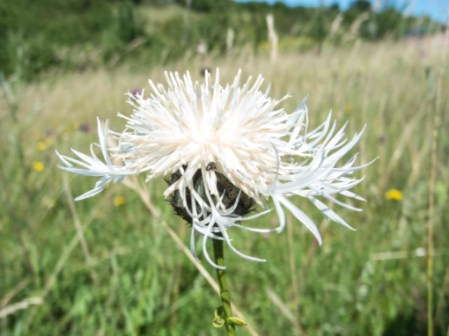
MONDAY
JULY 11 - 2016
Brook
Meadow
Looking north
in Palmer's Road Car Park one can see to see how the
trees of Western Balsam Poplar and White Willow
tower over all others in the copse.

Walk down the path
towards the south bridge to find a good flowering of
Ground-elder. It was attracting several insects
while I was there including this familiar black and
yellow beetle called Strangalia
maculata.
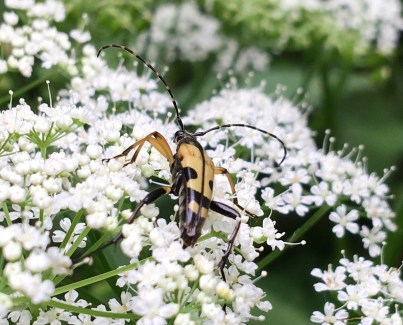
Meanwhile, onto the
meadow itself where Meadowsweet is in full
blossom and smelling sweetly.
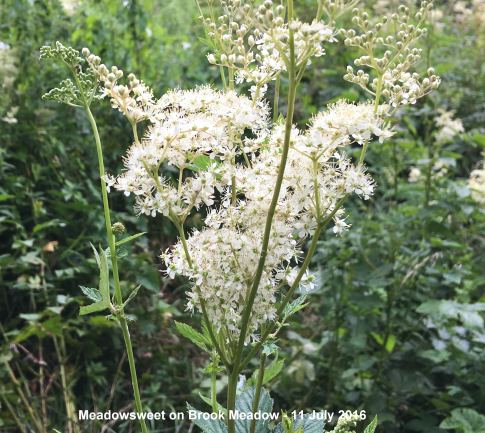
Hogweed flower
heads are standing tall already. Here is a shot of
some with Tall Fescue in front, typically bending
sideways, taken on the north west path near to the
steps up the north bridge. Creeping Bent is also
growing well along this path.
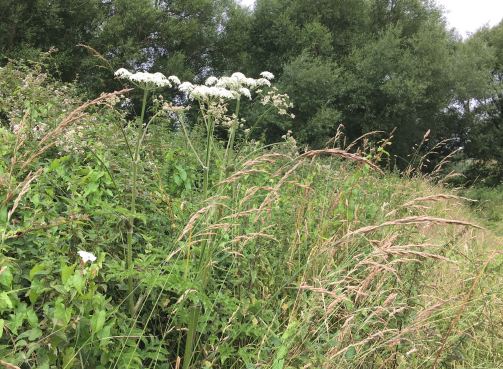
Waysides
There is a
good show of Fox and Cubs in flower on the
grass verge at the southern end of Church path. This
verge is privately owned and contractors cut it
frequently, but the flower are very attractive at the
moment and well worth making a diversion for.

SUNDAY
JULY 10 - 2016
Angel's
Fishing Rods
I had several
replies to my query about the grass-like plant with
red bell-shaped flowers that I found in Bishop's
Palace Gardens yesterday. Many thanks to Ralph
Hollins, Jill Stanley, Pam Phillips, Chris Oakley and
Hillary Wootton. All were agreed the plant is called
Angel's Fishing Rods (Dierama latifolius). Pam
actually has some in her front garden! For more
information about this attractive plant which is
certainly not a grass, though very grass-like, see . .
. https://www.rhs.org.uk/advice/profile?PID=99
New
generations
Barrie Jay
thought we would like to hear how some of this
season's youngsters are progressing in his garden. He
says it has been a busy breeding year, with all the
regular visitors having young. Robins have been very
successful -3 broods over a three month period! Barrie
provided us with some excellent images of four of the
leading lights: Nuthatch, Robin, Great Spotted
Woodpecker and House Sparrow.
I have also enjoyed
seeing several youngsters in my small town garden near
the centre of Emsworth. They include House Sparrow,
Robin, Starling, Blue Tit, Great Tit, Goldfinch and
Greenfinch. I was particularly pleased to see
Greenfinch youngsters as this species has been badly
affected by trichomonosis over the past 10 years. Here
is a young Greenfinch I snapped through the back
window on the feeder in the rain this morning. Before
you say, I know the feeder needs filling; I did fill
it immediately after the photo!
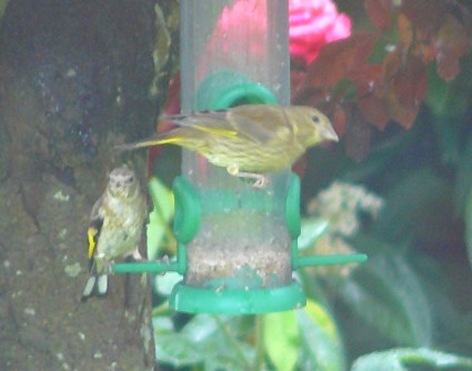
Barrie also had the
pleasure of seeing a Red Kite over his garden in West
Waterlooville last week, the third time he had seen
one over the last couple of months.
First
Gatekeeper
I was pleased
to see my first Gatekeeper of the year during a walk
through Brook Meadow this afternoon.
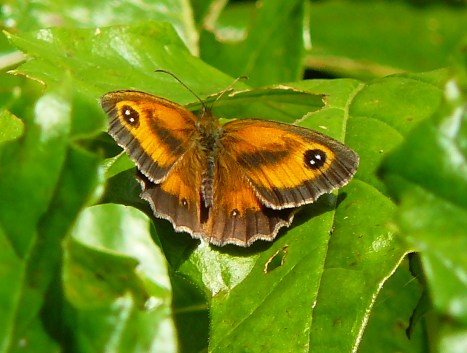
Nettle
Weevil
Eric Eddles
had another new insect at Baffins Pond today - a
Nettle Weevil (Phyllobius Pomaceus)
7-10mm.
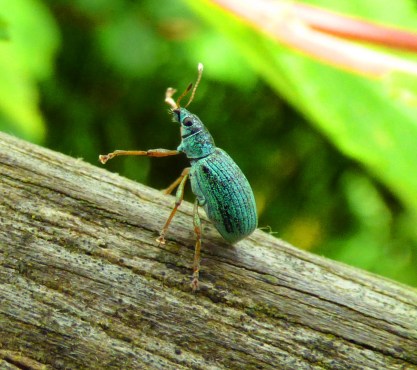
SATURDAY
JULY 9 - 2016
Drama
on Brook Meadow
At about 11am
this morning I had a phone call from a lady who told
me that Police, Environment Agency and Fire Brigade
were in Seagull Lane attending to a chemical spillage
into the river by the north bridge. I rushed up there
to find a police tape across the top of the lane.
Having identified myself as a member of the Brook
Meadow Conservation Group, I was allowed to pass
through to see what the problem was. The EA team
leader told me that there had been an overspill of
hydrogen peroxide from the anodising factory in
Seagull Lane into the drains. The chemicals had got
into the river through the pipe close to the north
bridge. While I was there several EA members were in
the river digging out contaminated stones from around
the pipe and taking them away in a large bin.

The manager of the
factory was present and was very apologetic about the
spillage. He said the chemical used in the anodising
process was kept in large tanks, but last night one
had overflowed. By 11.30 the worst of the spillage had
been removed or washed away downstream and all parties
considered the situation solved.
Bishop's
Palace Gardens
Jean and I had
a walk around Bishop's Palace Gardens in Chichester
this afternoon. They were a blaze of glorious colour
from the flower beds. What a great show, even for a
lover of wild flowers like myself.

We saw a large tuft of
a puzzling grass-like plant with red bell-shaped
flowers. What is a grass doing with flowers? Does
anyone know what they are?

Chichester
Peregrines
I stopped at
the RSPB stall, now in front of the Cathedral, where I
had a chat to a warden from the Brighton area. She
told me that the four chicks (three males and one
female) successfully fledged a few weeks ago and were
now healthy and flying well. The chicks were all
ringed with white numbers on a black background; this
year the numbers are 66, 67, 68 and 69. All sightings
should be reported to the British Trust for
Ornithology. She expected the parents would soon be
taking the youngsters over to the harbour to hone
their hunting skills. The RSPB stall will be closing
down tomorrow.
For some excellent
photos of the four juvenile Peregrines go to . . .
http://www.chichesterperegrines.co.uk/galleries/June%202016%204%20in%20turret/gallery.htm
Field
Cow Wheat
Ralph Hollins provided more information about the
magnificent Field Cow Wheat photographed by Peter
Milinets-Raby yesterday at Skew Road, Portsdown
Hill.
Ralph says, "The Hants Plants page on the Rare Plants
Register which was published as a PDF in 2011. The
following is an extract from that PDF which shows that
the plants have been found sporadically in Hampshire
since 1863. I understand that the introduction to
Portsdown was made by a mythical 'Portchester Postman'
but regardless of how they arrived they have been
thriving there since at least June 1999. For more info
see http://www.first-nature.com/flowers/melampyrum-arvense.php
Warblington
shore
Peter
Milinets-Raby was out this morning for a walk along
the Warblington shore (6:35am to 8:48am - low tide).
His report as follows:
Warblington cemetery: Great Spotted Woodpecker
juvenile with red crown, 3 Green Woodpecker - Female
with two young dancing around the trunk of a tree.
Ibis Field: Blackcap singing and Chiffchaff singing,
Med Gull over.
Hedgerow behind Conigar Point: Blackcap singing, Reed
Warbler.
Conigar Point: 4 Med Gulls, 4 Swift over, 2 Shelduck -
the lingering pair, 2 Common Tern, 14 Herring Gulls, 7
Black-tailed Godwits heading west towards the Hayling
Bridge, Chiffchaff singing from the Tamarisk
Hedge.
Off Pook Lane: Common Gull - adult - very stunning and
smooth looking! Great Crested Grebe, 4+ Redshank, 20
Black-tailed Godwit, 2 Greenshank - both un-ringed, 2
Stock Doves, 6+ Med Gulls, 3 Swallow, Pied Wagtail
juv.
Horse paddock: 1 Green Woodpecker feeding on the
grass. Chiffchaff singing, 11 Swallows, 3 Moorhen.
Langstone Mill Pond: 2 singing Reed Warbler & 2
others seen. 1 Cormorant.
Tufted Duck female with one lonely tiny duckling at
the rear of the pond. I hope this is another female
with a fresh hatchling and not the bird from the other
day and she has lost 12 ducklings! There were up to
four females present on the pond during June?
Grey Heron - Other Holm Oak nest - three young still
being fed. And, a single young on the Holm Oak nest.
Lesser Black-backed Gull over along with 4+
Swallows
FRIDAY
JULY 8 - 2016
Lime
leaf galls
Regarding the
red spikes on the lime leaves photographed by Brian
Lawrence on Brook Meadow yesterday, John Arnott says,
they are sometimes called Nail galls - for obvious
reasons as they look like nails that have been
hammered in to the leaf. John usually sees them later
in the season when they have turned brown.
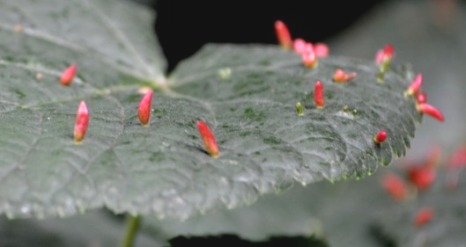
According to the Field
Studies Council book 'British Plant Galls' there are
two mite causers.
Eriophyes tiliae on Large-leaved Lime.
Galls are usually > 8 mm tall, with pointed
tips.
Eriophyes lateannulatus on Small-leaved
Lime. Galls are c. 5 mm tall, with rounded tips.
Both galls occur on Common Lime and on other planted
hybrids. The galls Brian got yesterday have pointed
tips so presumably are Eriophyes
tiliae
Orchid
counts
Georgie from
the Chichester Harbour Conservancy e-mailed me to say
the Southern Marsh Orchids on Fishbourne Meadows are
going to be counted by the end of next week,
hopefully. Cattle are going in around the 11th too.
Having seen the height of the grasses and reeds on the
meadow, I wish the counters the very best of luck!
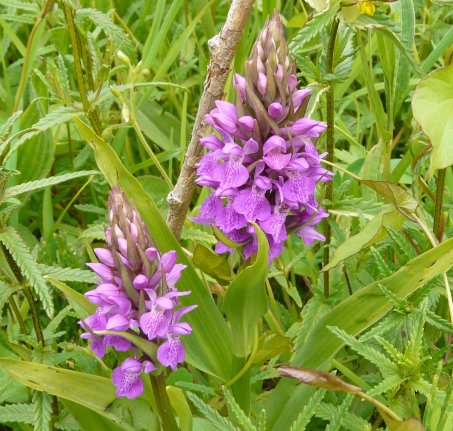
Langstone
Mill Pond
Peter
Milinets-Raby had an hour visit to the Langstone Mill
Pond (from 12:05pm to 1:12pm - tide slowly moving in).
His observations:
Off Pook Lane: 4 Greenshank (2 with rings, but too
distant and heat haze - really!!), 3 Med Gulls, 2
Shelduck, 3 Sandwich Tern, 1 Common Tern, 2 Great
Crested Grebes, 1 Whimbrel.
On the pond: eclipse plumaged Gadwall male (see photo)
and eclipse plumaged female Shoveler (first of he
year, a sure sign autumn is now on its way). Reed
Bunting male singing, Grey Heron feeding at the back
of the pond (see photo). 1 Reed Warbler, 2+ Swallow
& 1 Swift, 61 Little Egrets counted.
Peter
went again to Skew Road (Portsdown
Hill) to get a photo of what he calls
this "fantastic alien looking plant"!
The patch has spread onto the north
side of the fence and covers several
square metres - Magnificent! Worth a
visit!
|
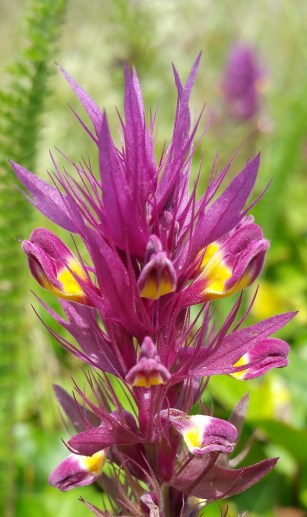
|
THURSDAY
JULY 7 - 2016
Sandy
Point
I enjoyed a
very pleasant and informative walk around Sandy Point
Nature Reserve in the south east corner of Hayling
Island this morning. The walk was attended by around
20 people and led by local naturalist John Arnott.
Members of the Chichester Harbour Conservancy and the
Hampshire County Council Ranger Service were also
present. I was pleased to meet up with John for the
first time. John has been an occasional expert
contributor to this blog over the years. Here is a
photo of John pointing out some aspect of the local
plantlife to the group.

I was also very
pleased to see Pete Potts who looked very well after
his serious illness, though he is still not back in
full time work. I know Pete best from his bird ringing
work, though he was, until his illness, HCC ranger for
this area of Hayling Island. Here is Pete on the left
of the group with John.

Another person I was
surprised to see on the reserve was Roy Ewing from the
Nore Barn Conservation group. Roy explained that he
and other volunteers regularly came onto the site to
help in management jobs. Good work, Roy.
I used to visit the
Sandy Point reserve regularly in the past, but I have
not been there for many years, so today's walk was a
good opportunity to reacquaint myself with this unique
area of coastal heath, acid grassland and sand dune.
Please note, this reserve is a protected area and
there is no unauthorised access. The reserve is
managed mainly through scrub clearance and by grazing
from a small group of 6 Highland cattle. Here they are
today, munching the grass. Fine creatures.
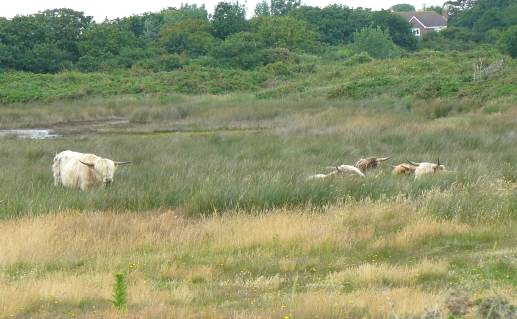
At one point on the
walk Georgie, one of the Chichester Harbour
Conservancy rangers, spotted a grass which had been
puzzling her at other sites. It appeared to have a
bright yellow band around the stem. One theory was
that it was a fungus that had attacked the grass, but
no one really knew. I brought a piece home with me to
cut it open. The yellow was like a tight sock around
the grass. Other views welcome, of course. Here is a
photo showing the yellow band - taken against Pete's
sweater.
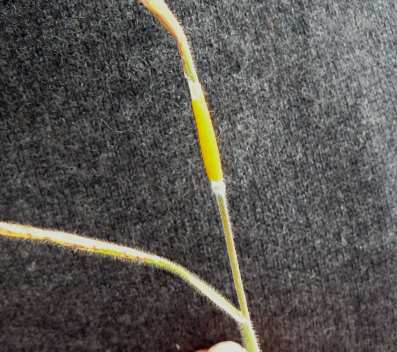
It
is Choke Disease Fungus
Ralph Hollins came
up with the answer to the grass with the yellow
collar. It is called Choke Disease Fungus
Epichloe typhina. The fungus forms a
sterilising 'collar' round the stem of the grass where
the immature flowers are, and reduces flowering and
seed production. The collars start as white early in
the cycle and later, as the spores develop, they will
turn yellow or orange.
See . . . http://naturalistsnotebook.mnapage.info/2013/06/14/choke-disease-fungus/
Having previously seen white flowered Creeping
Thistles on the Railway Wayside here in Emsworth, I
was pleased to see several Marsh Thistle plants
also with white flowers. Martin Rand tells me that
white Marsh Thistle are more common than Creeping
Thistle.
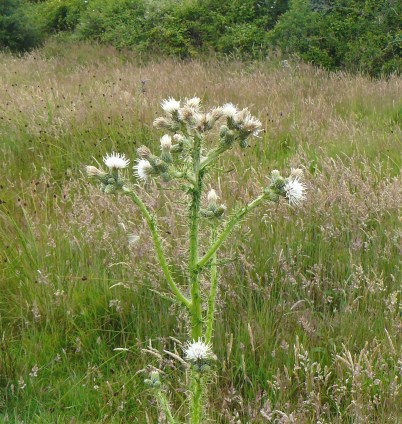
I was really pleased
to a fine array of Sea Holly just coming into
flower near the southern fence by the beach. This must
be the best spot locally to see these lovely plants.
They can easily be seen from the public area on the
other side of the fence. Interestingly, Sea Holly is
an umbellifer and unrelated to other hollies.
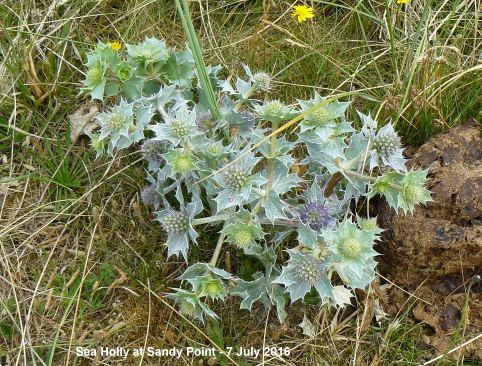
Pete pointed out to me
what was probably the best crop of Sea Spurge
in the Solent area. They are growing outside the main
reserve against the outer fence by the single beach.

Also growing together
near the fence were English Stonecrop,
Hare's-foot Clover and Sandwort,
finished flowering.
I was particularly
pleased to see that some plants of Common Ragwort
had been spared in the regular Ragwort pulling
sessions. This plant, as John explained, has
considerable ecological value in providing nourishment
for a variety of insects, such as the Cinnabar
caterpillars we saw feasting on one of the plants
towards the end of the walk.

Some members of the
group got quite excited by a very tatty small blue
butterfly which was thought could be a rare
Long-tailed Blue. Here are a couple of shots I got of
the insect. I think they rule out the Long-tailed Blue
as there is no obvious tail and the underwings clearly
show a pattern of spots. This suggests one of the more
common blue butterflies (not necessarily Common Blue),
but which one I would not hazard a guess as the edges
of the wings are completely gone.
I spotted a hoverfly
perched on a leaf which I think might be Scaeva
pyrastri. John will correct me if I am wrong.
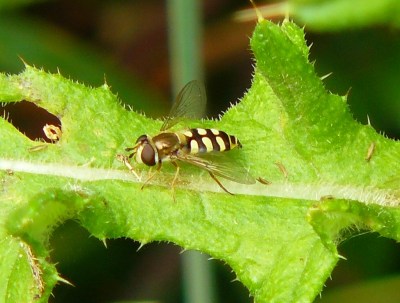
Other plants noted:
Hedge Bedstraw, Ladies Bedstraw and Sand Sedge. Lots
of Marbled White and Meadow Brown butterflies were
flying. Pete Potts also spotted a Small Copper.
Brook
Meadow
Brian Lawrence
spent a couple of hours on meadow this afternoon and
saw a Lacewing. He was also puzzled by leaves
on a tree by the railway bridge by Lumley lane with
red spikes on them. This is presumably caused by an
insect. I recall having seen them before, but can't
recall off hand what they are.
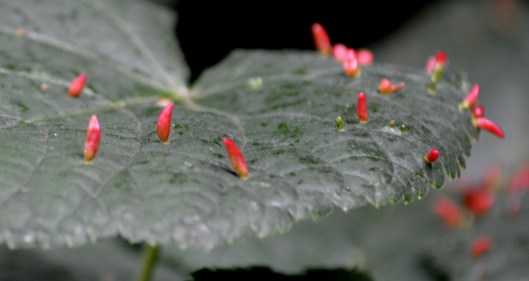
They
are Lime Gall Red
Thanks again
to Ralph Hollins for an answer to the red spikes. They
are 'safe houses' in which the larvae of the gall mite
Eriophyes lateannulatus can develop without being
eaten. See . . . http://www.tree-guide.com/lime-gall-red
Yellow
Foxgloves
Ralph Hollins
provided some extra information on the yellow
foxgloves that Peter Milinets-Raby photographed in
yesterday's blog. Ralph says "they have been growing
wild on Portsdown for at least 20 years though the
steep hill slope above Nelson Lane on which they are
found is nowadays thickly covered with scrub and I am
surprised that any can still be found. These plants of
Digitalis lutea are normally called
'Straw Foxgloves' to distinguish them from
Digitalis grandiflora which is also a
popular garden plant known as Yellow Foxglove.
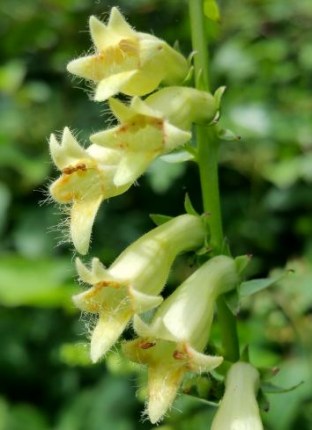
The Straw Foxgloves
almost certainly are of garden origin but have
survived as a wild population for a lot longer than
would normally be expected and when I had a car I
would look for them each year and happily tick them as
'survivors' along with the magnificent Field Cow-Wheat
which is only to be found, according to botanic
purists, on the Isle of Wight though hundreds of
plants have been seen in the past ten years under the
wooden fencing separating the informal parking area
beside Skew Lane from the motorway bank."
Orchid
counts
Georgie from
the Chichester Harbour Conservancy told me during the
walk at Sandy Point this morning that there had been
problems at Fishbourne Meadows. The grasses were very
high this year and the annual Southern Marsh Orchid
count had not been done. She confirmed that cattle are
due on the site shortly. That's good. They are needed!
Nigel Johnson also
e-mailed to say he had not been able to arrange the
annual Southern Marsh Orchid count on the Southmoor
this year. This is a pity as we have counts going back
to 1995 when Ralph Hollins did them. They were taken
over by the Havant Wildlife Group who did them until
2015 when they were done by Hampshire Wildlife Trust
Beechcroft Monday Team.
Here is a summary of
the Southmoor counts year by year
1995 - 6763 . .
. 1996 - 4319 . . . 1997
- 2407 . . . 1998 - 4890 . . . 1999 - 333 . . . 2000 -
5614 . . . 2001 - 491
2002 - 5086 . .. 2003
- 4474 . . . 2004 - 5561 . . . 2005 - 5129 . . . 2006
- 3234 . . . 2007 - 1367 . . . 2008 - 996
2009 - 4142 . . . 2010
- 9234 . . . 2011 - 8805 . . . 2012 - 7865 . . .2013 -
7420 . . . 2014 - 10690 . . . 2015 - 7786
WEDNESDAY
JULY 6 - 2016
Waysides
News
I had a little
wander around some of the local waysides this morning
to see if there had been any significant changes. The
Greater Burdock at the end of the path from
Washington Road is almost in flower. The red petals
are starting to show as in this photo.
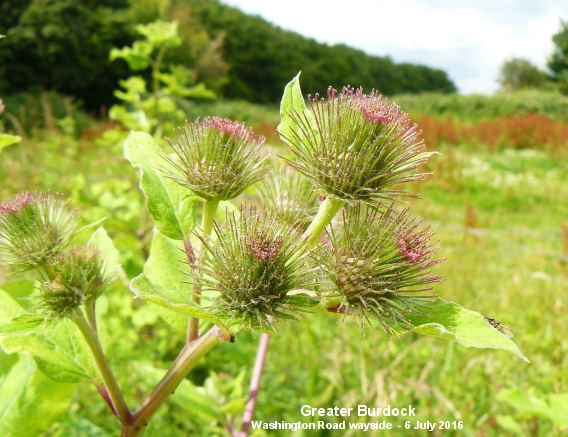
I saw my first
Small Skippers of the year on the wayside at
the junction of New Brighton Road and Horndean Road.
This photo shows the distinctive fine scent line on an
otherwise plain wing.
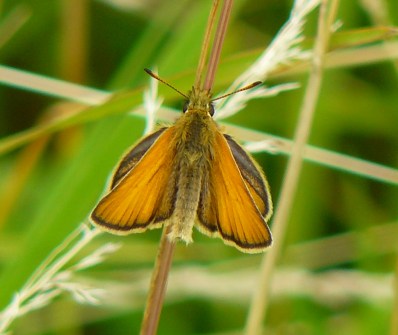
Marsh Woundwort
is now showing very nicely on the Railway Wayside.
Several flowers can be seen from the access ramp to
the north of the station. Common Centaury is in
flower. I also saw my first Common Fleabane of
the year in flower.
Langstone
Mill Pond
Peter
Milinets-Raby popped down too Langstone Mill Pond this
morning (10am to 10:45am - low tide). His report as
follows:
"The highlight was a
female Tufted Duck with 13 ducklings (I only counted
11 to start, then discovered 13 in the photos!). The
female was keeping them in the water under the
overhanging vegetation, so they were not always on
show.
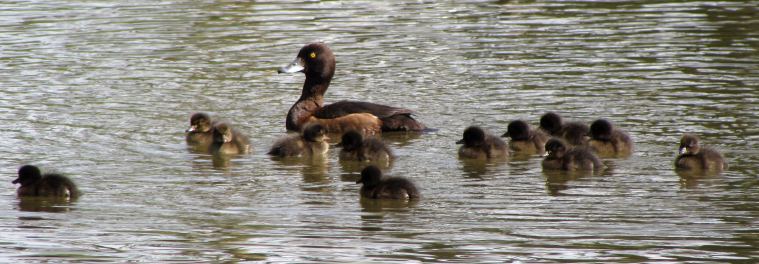
Other birds of note
were 3 Black-'Baled' Godwits, 3 Great Crested Grebes,
4 + Med Gulls. Noisy Black-headed Gull chicks have
arrived to the shore. I counted three (see photo).
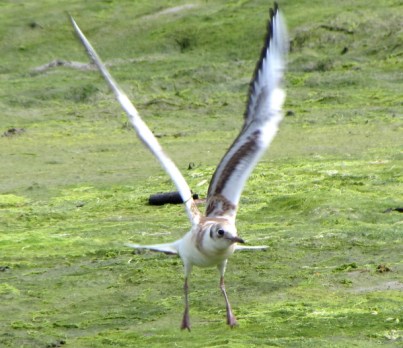
2 Swifts over and 5
Swallows. Reed Bunting male seen singing still.
Peter also got a shot of some Yellow Foxgloves
during a ten minute break at lunchtime at Skew Road
(Portsdown Hill). I think they are garden flowers?

Martin's
comments
I am very
grateful to our BSBI South Hants Recorder, Martin
Rand, for proving the following valuable and thought
provoking comments on recent botanical issues in this
blog:
Regarding the Spiked
Star-of-Bethlehem (Ornithogalum
pyrenaicum) at Fishbourne, Martin says it has
been known in the Fishbourne area for nearly 100
years, and at Appledram Lane for nearly 30 years. So
he agrees we can fairly say it's naturalised. Also,
Fishbourne being Fishbourne he thinks it could be a
Roman introduction, but one can only
speculate!
I also raised the
issue as to whether it matters about the plant being
introduced. Martin commented on this as follows: "No,
I don't think it matters from the point of view of
pleasure in seeing the plant, except that many
people's enjoyment is enhanced by seeing it in its
'original' habitat and getting some idea of its place
there. To take another example, I'll get some pleasure
in seeing Purple Gromwell escaped into a Hampshire
hedgebank from an adjoining garden, but it isn't the
same as seeing it on the floor of a wood in the
Mendips. I think it matters from a scientific point of
view in understanding its original natural range, or
some aspects of its ecology. It may also matter from a
conservationist point of view if (as in this species)
there are genetically different races whose occurrence
is poorly understood but probably splits between
native and introduced, and you want to know what
you're trying to conserve."
I asked Martin if the
same argument could be applied to the Great
Burnet on Brook Meadow and to the Wild
Clary on the wayside in Christopher Way - ie, not
their 'natural' home, but introduced and living
happily. Martin replied "the Wild Clary could be a
native relic, as it's not really out of geographical
range nor even habitat exactly. The Great Burnet is a
bit more dubious, as it's outside its previously known
geographical range in the immediate region, not
exactly in typical habitat, and it's a bit suggestive
that it only got noticed recently given how well you
and many others know Brook Meadow. Sometimes these
things will be undecidable, and we just have to lie
back and enjoy them! :-) Clary is more of a coloniser
than Great Burnet, so its appearance, even if recent,
could be more 'natural'."
TUESDAY
JULY 5 - 2016
FISHBOURNE
Following a
discussion on Facebook about Bath Asparagus (aka
Spiked Star-of-Bethlehem), I thought I would drive
over to Apuldram near Chichester to have a look at a
regular site for these plants on the roadside verge at
Appledram Lane (south).
Spiked
Star-of-Bethlehem
I first saw these spectacular flowers on this verge in
June 2009 when I counted 78 spikes. This particular
occasion stands out in my memory as I was due to lead
the Havant Wildlife Group the next day to see the
flowers, but when we got there they were all gone!
Mown flat, apparently, by local person annoyed about
the state of the verge. Today, the plants were there,
but almost all of them had gone to seed. I did manage
to find one plant with some flowers still present, but
all the others just had seed pods.
This crop of Spiked
Star-of-Bethlehem plants is well known to local
botanists and is recorded in the New Flora of Sussex
for tetrad SU80M. As a native the plant is said to be
very local and restricted to the counties of Somerset,
Wiltshire, Gloucestershire, Berkshire, Bedfordshire
and Cambridgeshire - not Hampshire or West Sussex! I
don't know how it got here, but Martin Rand thinks it
was introduced. Introduced or not, the plants are now
well established despite having undergone a traumatic
history. It would not be correct to refer to it as a
'casual'. The plant gets its name Bath Asparagus, as
its young shoots were formerly marketed in Bath as
Asparagus. It is a bulbous perennial and flowers in
June. See Martin's comments on the next day's blog.
Hairy
Bindweed
At the
southern end of the Appledram Lane verge were two
flowers of the unusual Hairy Bindweed
(Calystegia pulchra). I also saw this
plant in June 2009 - fortunately it did not get mown
with the rest. With its large pale pink flowers and
white stripes it looks like Sea Bindweed; however, the
leaves of the plant are not kidney-shaped, as they
should have been for Sea Bindweed, and the plant also
has inflated bracts completely enfolding the sepals,
like Large Bindweed. Also, the flower stalks are hairy
- which gives the plant its common name.
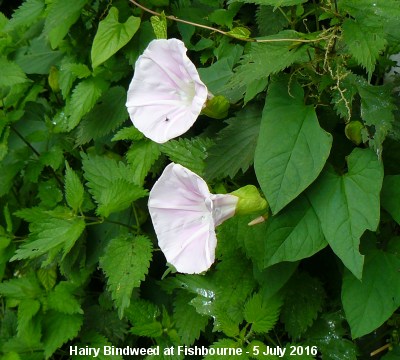
Calystegia
pulchra is recorded in the New Flora of Sussex
for SU80M, so the plant is already known. In "The Wild
Flowers of the British Isles" by Garrard and Streeter
(p.279) it is described as "An alien whose origin is
something of a mystery, but it probably appeared as a
garden hybrid somewhere in Europe. It is a local plant
scattered throughout the British Isles and is most
frequent in the south-east and north-west of England
where it usually appears close to gardens. It flowers
from July to September." It is certainly well
established in this location, not a 'casual' and worth
seeing soon before the flowers go.
Fishbourne
Meadows
I also had a
walk round Fishbourne Meadows which I found a little
disappointing. The east meadow was fine with some
Southern Marsh Orchids still in flower, but the main
west meadow was very overgrown with tall reeds and
very few orchids. I will ask the Chichester Harbour
Conservancy for their annual orchid count and ask if
grazing is still taking place. I was also saddened to
see the river bank fenced off with metal fencing and a
line of barbed wire at the top. This is presumably to
prevent cattle getting into the stream, but thank
goodness we don't have to do that on Brook Meadow.
I
was pleased to see several plants of
Marsh Ragwort which we don't get
at all on Brook Meadow despite the
habitat being right for it. The reddish
stems and the leaves with large rounded
end lobes and distinctive.
I found
a substantial Blue
Water-speedwell plant growing
beside the first wooden bridge over the
river. Its spikes appeared to have well
over 30 flowers, so I assume it is the
hybrid variety - Veronica x
Lackschewitzii.
I also
noted some bushy specimens of Fool's
Water-cress along the river. It
does not usually grow in this form.
|


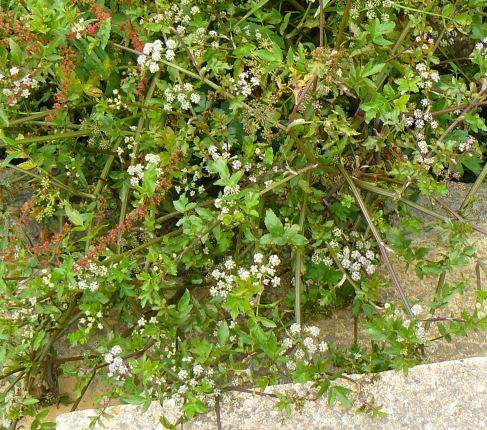
|
Fishbourne
Millpond
I walked
through to have a look at the millpond where I found
the usual large plants of Greater Tussock Sedge
on the edge of the pond.

The pond itself was
largely covered by a mass of Marestail - I
don't recall having seen this plant anywhere else
locally. Note: Marestail is quite different from
Horsetail which grows on land.

PS There is a
new notice at the entrance to the Fishbourne Parish
Church car park to say this is a private car park and
unauthorised parking is not allowed. This must have
appeared since the new church hall was built. As there
is no other easy parking for visitors to Fishbourne
Meadows this seems a bit unreasonable. Personally, I
shall ignore it. I have been using the car park
frequently over the past 40 years with no problems.
Stag
Beetle
Chris Oakley
rescued a Stag Beetle from a water filled pot today,
which could be a Lesser Stag Beetle. He says, "I can
only see one spine on the tibia but the head/pronotum
does not seem to be of that type. The length, as you
can see is about 20mm. What do you think?" I will
leave that to the experts. Any offers?
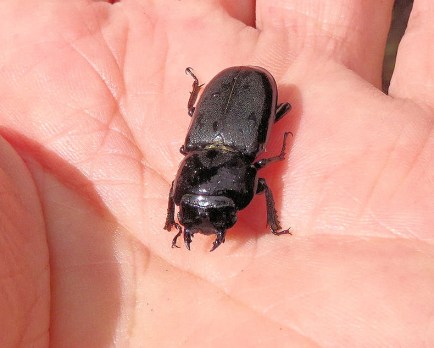
MONDAY
JULY 4 - 2016
This morning I walked
from Seagull Lane to Lumley Mill and then down Lumley
Road to Slipper Millpond and back via Brook Meadow. I
had quite a few interesting observations as follows:
Lumley
There is
currently a nice selection of wild flowers along the
edge of the path leading from the end of Seagull Lane
to Lumley Mill. This path was heavily sprayed with
herbicide last summer, which seems to have given the
plants a new lease of life! They include Enchanter's
Nightshade, Great Willowherb and Broad-leaved
Willowherb - I think, for Willowherbs are
tricky.
Broad-leaved
Willowherb and Great
Willowherb
|
Greater
Celandine is also hanging on at the end
of the path near the bridge. I am amazed how
these delicate petals ever remain on the
plant when a slight puff of wind would seem
to blow them off.
|

|
|
Walking down
Lumley Road I stopped to check the
Skullcap that usually flowers on the
wall of the Lumley Stream outside Lumley
Terrace cottages. It is still there an
looking good, though there's not an awful lot
of it.
|

|
|
Brook
Meadow
Moving down
Lumley Road past the cottages I came to the
area by the stream which is part of the Brook
Meadow site. It was here that I found the
usual growth of False Brome with its
distinctive panicles spikelets on short
stalks. This is a new grass for this year
taking the total list for 2016 to 28.
I also noted
Feverfew, Wood Sedge and Grey Sedge along
this roadside. Blackcap and Chiffchaff were
singing strongly from Lumley copse.
|
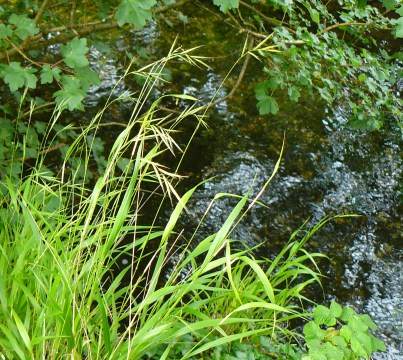
|
|
The
Japanese Honeysuckle is flowering
nicely just outside the Lumley gate. This is
the species with black berries.
|
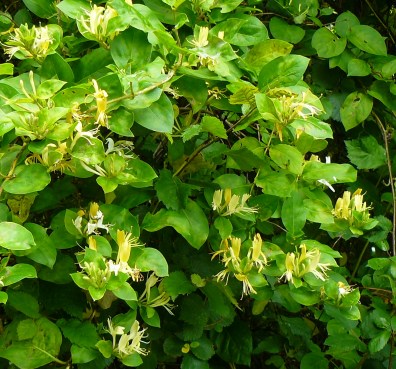
|
|
Peter
Pond
On to Peter
Pond where Perennial Sow-thistle and Wild
Carrot are flowering well and the very tall
plants of Prickly Lettuce tower over
everything else, but not yet in
flower.
While I was
there one of the Great Black-backed Gulls
came onto the pond and then flew off towards
Brook Meadow. White swan feathers were on the
east bank which probably indicates the recent
presence of the Mute Swan family. I did not
see anything of them today, but I gather the
family is now down to 3 cygnets.
|
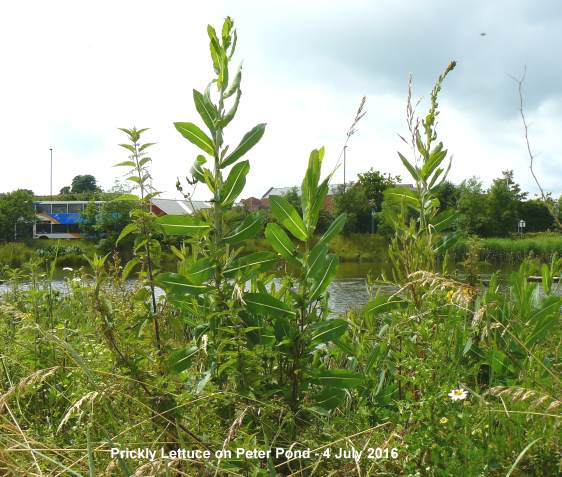
|
Slipper
Millpond
The
other adult Great Black-backed Gull was
snoozing on the centre raft of Slipper
Millpond with two of its youngsters in
close company.
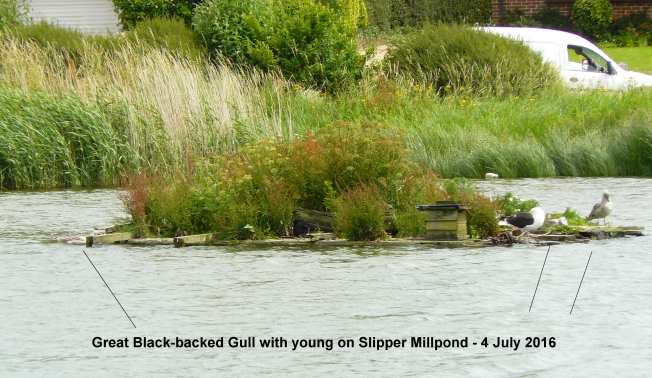
|
Meanwhile,
the third young gull was on the water
swimming round the raft
where it had a mini skirmish with a Coot.
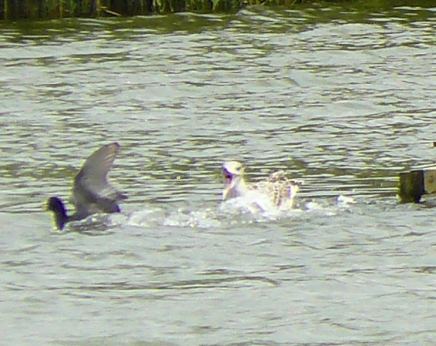
|
Brook
Meadow
Coming back
over the south bridge, I stopped to check the regular
Brown Trout which was, as usual, swimming
happily a little way upstream.
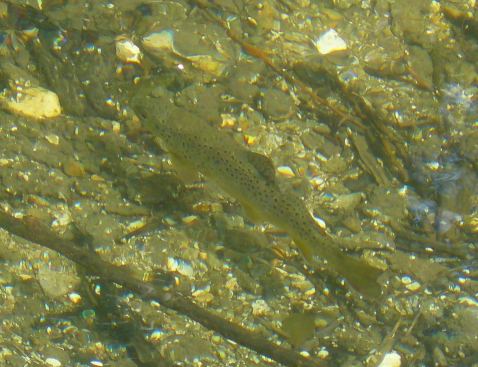
Fool's
Water-cress was flowering in the river beneath the
bridge. This is often confused with Water-cress, but
as shown in the following photos the flowers are quite
different. Fool's Water-cress is, in fact, an
umbellifer.
SUNDAY
JULY 3 - 2016
Brook
Meadow
I went over to
the meadow this morning for the regular first Sunday
in the month work session. Put my wellies on to go
over, but I did not really need them. Good group of
volunteers including two grand children of Jennifer.
Ian led in the absence of Maurice.
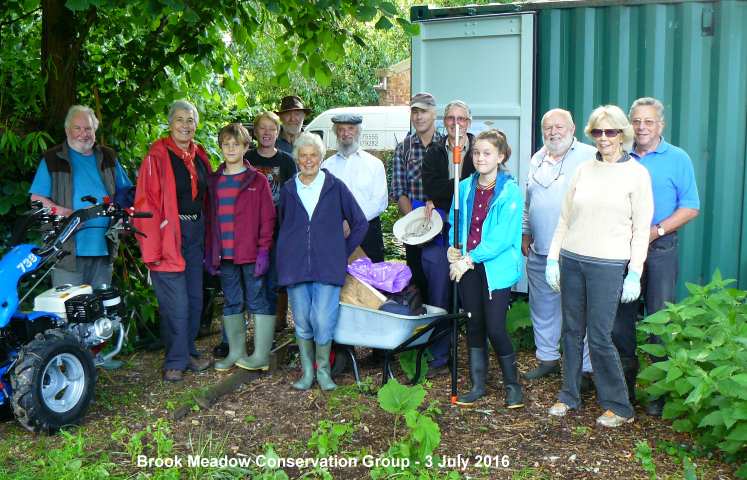
Birds singing included
Whitethroat and Blackcap, plus the usual regulars, but
no Chiffchaff this morning. I spotted a few
butterflies, Red Admiral, Comma, Meadow Brown and
Ringlet but no photos. There were several Beautiful
Demoiselles flying around the waterways of which I
captured this female. I also got an Azure
Damselfly.
Sharp-flowered Rush
is now widespread on the Lumley area, more so than
I have seen it before. This plant was first recorded
on the Lumley area in June 2009 and has expanded
rapidly since then to the a dominant plant of the
area.
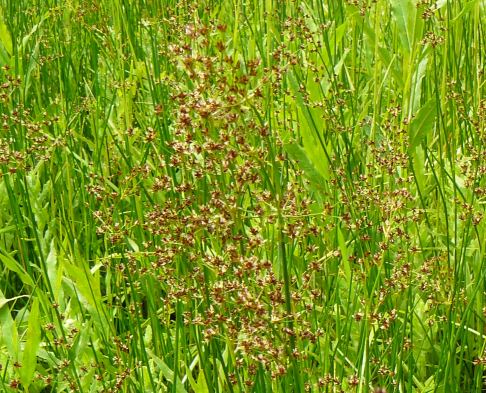
Meadowsweet is
now flowering and smelling strongly along the path on
the east side of the north meadow.

Blue
Water-speedwell
I went down
onto the west bank of the river in Palmer's Road Copse
to have a look at the possible Water Vole burrow holes
in the far bank, but did not see any activity. I found
several plants of Blue Water-speedwell with fairly
long flower spikes, indicating they are probably the
hybrid with Pink Water Speedwell ie, Veronica x
Lackschewitzii. Here is a spike with at least
36 flowers that I pulled off to demonstrate.
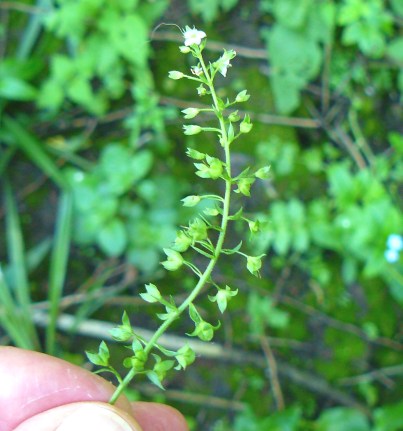
I recall the old BSBI
Recorder for South Hants, Pete Selby, telling me that
if the flower spike had more than 20 flowers then it
was the hybrid and not the pure form of Blue
Water-speedwell. However, the Plant Crib (1998 p. 263)
gives a mean of 25 flowers (range 15-40) for the pure
form and a mean of 60 (range 30-90 for the hybrid, so
maybe the 20 limit is probably not quite as precise as
Pete led me to believe and these plants could be the
pure form of Blue Water-speedwell (Veronica
anagallis-aquatica).
Water-starwort
There are
several patches of a Water-starwort floating in the
river. I hesitate to say which species particularly as
Rose (New Ed p. 384) specifically states that
Water-starworts cannot be identified without ripe
fruits.

However, during his
survey of the River Ems on 13 June 2005, Andy Powling
found what he thought was the relative uncommon
Blunt-fruited Water-starwort (C.
obtusangula) rather than Common
Water-starwort. He pointed out that it had floating
rosettes and spoon-shaped leaves, strongly veined
above with 3 distinct veins. The Hants Flora does not
show records for C. obtusangula in the Brook Meadow
area, but there are records close by. Blunt-fruited
Water-starwort (C. obtusangula) was
subsequently confirmed in the river on Brook Meadow by
Martin Rand on 3 July 2005.
Meadow
Barley
Just before
the workday coffee break I went looking for Meadow
Barley on the centre meadow where I have found some in
previous years. I quickly located a small patch at
Grid Ref: SU 75094 06030. That takes the total number
of grass species (not counting sedges and rushes)
recorded on Brook Meadow this year to 27.
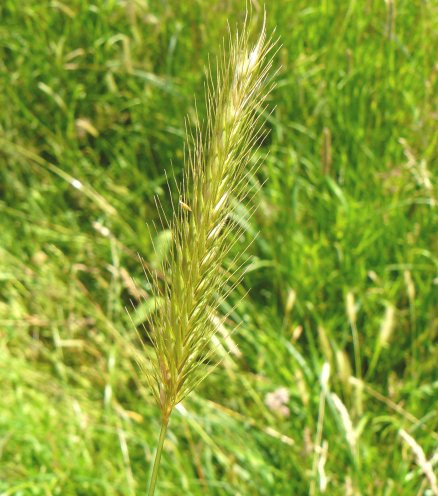
Awned
Couch Grass
I also had a
look at the Water Vole burrows on the east bank of the
Lumley Stream where I actually saw and photographed a
Water Vole on June 4, but there was no sign of any
vole in the 10 minutes I waited today. While I was on
the Lumley Stream bank I noticed several spikes of a
heavily awned Couch Grass pushing up through the mass
of Michaelmas Daisies that grow there. I gather from
Rose (Grasses, p. 132) that Common Couch is sometimes
awned, but these awns seem very long. Could it
possibly be Bearded Couch? Martin Rand identified an
awned Common Couch on Brook Meadow during his visit on
3 July 2005. Here is a photo of part of a panicle that
I brought home. The full length was 19cm.
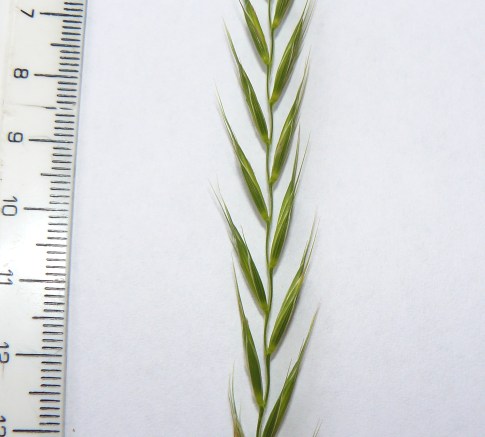
Warblington
Peter
Milinets-Raby I was out this morning for a proper walk
after a lazy June. He walked the Warblington shore to
the pond and back (6:50am to 9:12am - tide pushing in
slowly, chilly wind, felt like autumn!
Warblington Cemetery: 2 Stock Doves and
Pheasant heard. And flowers taken with mobile phone
again - English Stonecrop and Selfheal.
Off Pook Lane:
2 Great Crested Grebe with one distantly off Conigar
Point, Little Owl in the usual tree, Med Gulls 24+
(lots of singles and pairs flying south to Hayling,
plus two flocks of 8 & 9.). 2 Shelduck and 1
distantly off Conigar Point (and two separate on the
pond = 5). 17+ Swallow. 2 Kestrel, 3 Common Tern, 1
Sandwich Tern, 2 Greenshank (both with colour rings -
first returning birds - G//R + GO//- {seen in July in
2015 & 2014} and G//R + ON//- Surprisingly not
seen by me before! 1 Redshank (first for a month), 1
Rock Pipit flew west along the shore calling - odd
record?
Langstone Mill Pond: Pair of Shelduck, a pair
of Tufted Duck and 3 Swifts over heading south. Reed
Warbler 4 and one still singing. Reed Bunting still
singing, Great Spotted Woodpecker heard. Grey Heron in
Other Holm Oak has three young (second brood) and the
furthest nest south has two young (Nest 5 - second
brood).
Horse paddock: Green Woodpecker heard, Blackcap
still singing, 5 Moorhen, 2 Foxes.
SATURDAY
JULY 2 - 2016
Swan
attacks cygnet
I had an
e-mail from Angela Brown posted at 9.48 this morning
to say she had just been watching a male swan attack
and drown a cygnet in the pool in front of Slipper
Mill. I wondered if the dead cygnet was one of the
family from the nest on Slipper Millpond, which I
gather is now down to three cygnets, but Angela said
it appeared much smaller than those in the Pond
family. It seems likely that the poor cygnet had
wandered away from the safety of its parents and
became vulnerable to attack. This is not an uncommon
occurrence.
Plant
updates
Regarding the
white flowered Creeping Thistles I found on the
Railway Wayside on Thursday, Martin Rand said that
Creeping Thistle does occur with white flowers, but is
much less common than Marsh Thistle with the same.

Regarding the cluster
of Cotton Thistles (Onopordum acanthium) that I
found Next to the Wellness Clinic in Westbourne at
Grid Ref: SU 7544 0721. Martin said he would like a
full record for these plants. Interestingly Cotton
Thistle is described in the old Hants Flora as "Very
local and rare". Adding that . . . "Its distribution
in Hants cannot be readily reconciled simply with
random garden escapes. The records show it is more
frequent in the sandy regions of the NE and E". It is
a biennial plant occupying broken ground and therefore
rarely persists for long.
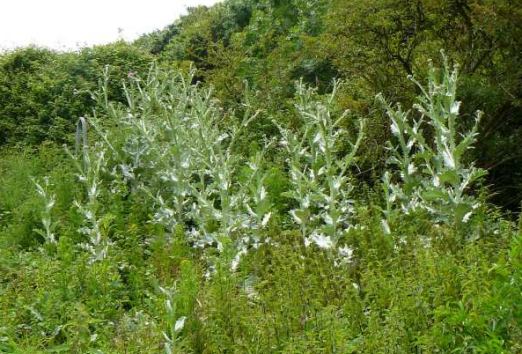
For
earlier observations go to . . June
14-30